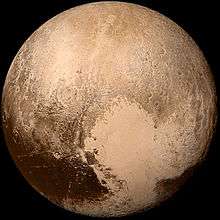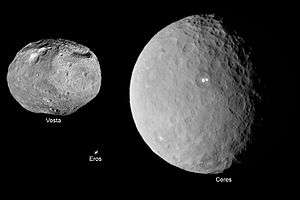AIDA (mission)
| Mission type | Asteroid probe |
|---|---|
| Operator | European Space Agency, NASA |
| Website | AIDA study |
| Spacecraft properties | |
| Launch mass |
DART: 300 kg (660 lb) AIM: |
| Start of mission | |
| Launch date |
AIM: October 2020[1] (proposed) DART: July 2021 (proposed) |
| Rocket |
AIM: Soyuz-STA/Fregat DART: Minotaur V[2] |
| (65803) Didymos[3][4] orbiter | |
| Spacecraft component | AIM |
| Orbital insertion | October 2022 (proposed) |
| (65803) Didymos[4] impactor | |
The Asteroid Impact and Deflection Assessment (AIDA) mission is a proposed space probe which would study and demonstrate the kinetic effects of crashing an impactor spacecraft into an asteroid moon. The mission is intended to test whether a spacecraft could successfully deflect an asteroid on a collision course with Earth.[5] It would be composed of two spacecraft: AIM, which would orbit the asteroid, and DART, which would impact its moon. Besides the observation of the change of orbital parameters of the asteroid moon, the observation of the plume, the crater, and the freshly exposed material will provide truly unique information for asteroid deflection, science and mining communities.
As of 2016, the mission is still in the conceptual phase with a proposed launch for AIM in October 2020, and for DART in July 2021. The impact of DART would be in October 2022 during a close approach to Earth.[3][6]
Collaboration
The AIDA mission is a joint international collaboration of the European Space Agency (ESA), the German Aerospace Center (DLR), Observatoire de la Côte d'Azur (OCA), NASA, and Johns Hopkins University Applied Physics Laboratory (JHU/APL).[3] The project was formed by joining two separate studies, called Double Asteroid Redirection Test (DART), an asteroid impactor developed by NASA, and a monitoring spacecraft - ESA's Asteroid Impact Mission (AIM).[3]
Mission design
AIDA would target 65803 Didymos, a binary asteroid system in which one asteroid is orbited by a smaller one. The primary asteroid is about 800 m (2,600 ft) in diameter; its small satellite is about 150 m (490 ft) in diameter in an orbit about 1.1 km from the primary. Didymos is not an Earth-crossing asteroid, and there is no possibility that the deflection experiment could create an impact hazard.[7] The assessment is ongoing.
Under the current proposal, AIM would launch in October 2020, and DART in July 2021. AIM would orbit the larger asteroid and study the composition of it and its moon. DART would then impact the moon on October 2022, during a close approach to Earth.[3][6] AIM would study in situ the effect on the asteroid moon's orbit around the larger asteroid. An equal timing of the experiment is set for both missions, and both spacecraft would be able to operate independently.
The impact of the 300 kg (660 lb) DART spacecraft at 6.25 km/s will produce a velocity change on the order of 0.4 mm/s, which leads to a significant change in the mutual orbit of these two objects, but only a minimal change in the heliocentric orbit of the system.[2][3][7] AIDA will provide data on the asteroid's strength, surface physical properties and its internal structure. There is great benefit to obtain the size of the resulting impact crater in addition to the momentum transfer measurement, as the effects of porosity and strength of the target are needed to calculate the momentum transfer efficiency.[3][7]
Fly-by of Orpheus
The DART mission is also proposed to make a fly-by observation of asteroid 3361 Orpheus during its trajectory to 65803 Didymos.[8]
Proposed payload
The payload is under assessment, and the notional requirements are:[2][7]
- AIM
- an asteroid lander (based on the German MASCOT heritage) for in-situ measurements
- a thermal infrared imager to discriminate different surface properties like rocks or granular surfaces
- a monostatic high frequency radar to obtain information on the structure of the asteroid's surface
- a bistatic low frequency radar (on the orbiter and on the lander) that allows a view inside the asteroid and obtain data on its inner structure
- two interplanetary CubeSats [9] out of five proposals currently under investigation that support the science and technology objectives of the AIM and AIDA mission
- deep-space optical communication
- DART
DART is a 300 kg (660 lb) impactor that hosts no scientific payload other than a 20-cm aperture CCD camera to support autonomous guiding to impact the target body through its center.
Status
Both AIM and DART have been approved for a Phase A/B1 study, starting in February 2015 for fifteen months.[7]
See also
References
- ↑ Winder, Jenny (6 April 2015). "Design work begins on asteroid lander mission". SEN News. Retrieved 2015-04-07.
- 1 2 3 Cheng, A.F.; Michel, P.; Reed, C.; Galvez, A.; Carnelli, I. (2012). DART: Double Asteroid Redirection Test (PDF). European Planetary Science Congress 2012. EPSC Abstracts.
- 1 2 3 4 5 6 7 Asteroid Impact & Deflection Assessment (AIDA) study.
- 1 2 "AIDA study". ESA. 19 December 2012. Retrieved 2014-09-19.
- ↑ AIDA mission rationale Archived May 11, 2015, at the Wayback Machine.. ESA, 25 May 2012.
- 1 2 Miriam Kramer (26 March 2013). "Asteroid Deflection Mission AIDA Set To Crash Two Spacecraft Into Space Rock In 2022". Huffington Post. Retrieved 2014-09-19.
- 1 2 3 4 5 "AIDA: Asteroid Impact and Deflection Assesment mission under study at ESA and NASA" (PDF). Observatoire de la Côte d'Azur. February 2015. Retrieved 2015-03-29.
- ↑ A.F. Cheng et al., "Asteroid Impact & Deflection Assessment mission: Kinetic impactor," Planetary and Space Science (Available online 4 January 2016)
- ↑ Cubesat Companions for ESA's Astroid [sic] Mission. Source: ESA. November 2, 2015.
External links
- Video: 5 min presentation of AIDA, at YouTube.


